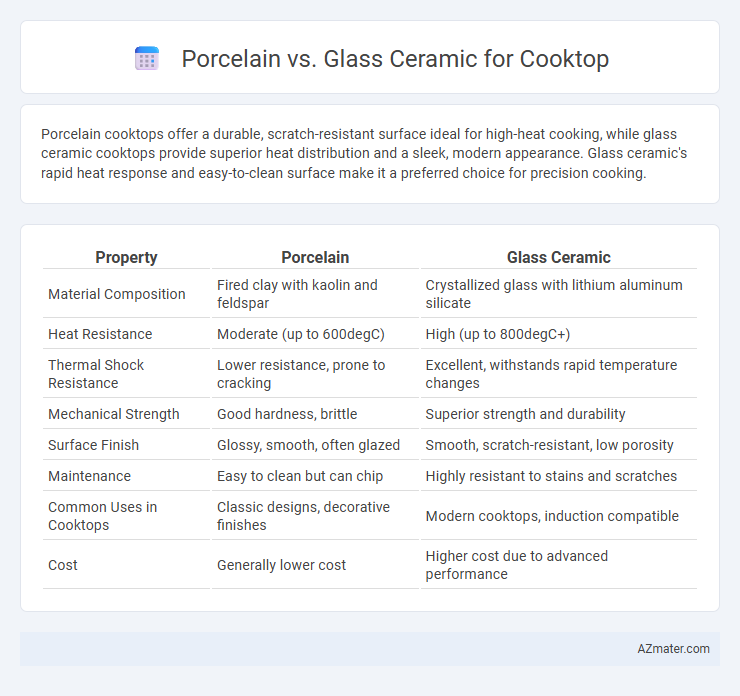Porcelain cooktops offer a durable, scratch-resistant surface ideal for high-heat cooking, while glass ceramic cooktops provide superior heat distribution and a sleek, modern appearance. Glass ceramic's rapid heat response and easy-to-clean surface make it a preferred choice for precision cooking.
Table of Comparison
| Property | Porcelain | Glass Ceramic |
|---|---|---|
| Material Composition | Fired clay with kaolin and feldspar | Crystallized glass with lithium aluminum silicate |
| Heat Resistance | Moderate (up to 600degC) | High (up to 800degC+) |
| Thermal Shock Resistance | Lower resistance, prone to cracking | Excellent, withstands rapid temperature changes |
| Mechanical Strength | Good hardness, brittle | Superior strength and durability |
| Surface Finish | Glossy, smooth, often glazed | Smooth, scratch-resistant, low porosity |
| Maintenance | Easy to clean but can chip | Highly resistant to stains and scratches |
| Common Uses in Cooktops | Classic designs, decorative finishes | Modern cooktops, induction compatible |
| Cost | Generally lower cost | Higher cost due to advanced performance |
Introduction to Cooktop Material Choices
Cooktop material choices primarily include porcelain and glass ceramic, each offering distinct benefits for kitchen use. Porcelain provides a durable, heat-resistant surface that withstands heavy cookware and frequent cleaning, while glass ceramic delivers a smooth, sleek appearance with rapid heat conduction and precise temperature control. Selecting between porcelain and glass ceramic depends on factors like durability needs, aesthetic preferences, and cooking efficiency.
Overview: Porcelain Cooktops
Porcelain cooktops feature a durable, enamel-coated steel or metal surface that offers a smooth, glossy finish resistant to chipping and scratching. They provide excellent heat distribution and can withstand high temperatures but may be prone to staining and discoloration over time if not properly maintained. Porcelain surfaces are often more affordable than glass ceramic alternatives while delivering reliable performance for everyday cooking tasks.
Overview: Glass Ceramic Cooktops
Glass ceramic cooktops, often made from a durable material called vitroceramic, provide excellent heat resistance and rapid temperature changes without cracking. These cooktops feature a smooth, sleek surface that enhances easy cleaning and modern kitchen aesthetics. Their ability to efficiently distribute heat and withstand thermal shock makes them a preferred choice over traditional porcelain cooktops in contemporary cooking environments.
Heat Resistance and Thermal Performance
Porcelain cooktops offer moderate heat resistance but can be prone to cracking under extreme temperature fluctuations, whereas glass ceramic cooktops excel in thermal performance with high heat resistance and rapid, even heat distribution. Glass ceramic surfaces withstand temperatures up to 1000degF, making them ideal for efficient cooking and energy savings. The low thermal conductivity of porcelain limits its ability to handle sudden heat changes, making glass ceramic the preferred choice for durability and consistent cooking results.
Durability and Scratch Resistance
Porcelain cooktops offer excellent durability due to their dense and hard surface, resisting everyday impacts and high temperatures effectively. Glass ceramic cooktops feature superior scratch resistance, thanks to their smooth, non-porous surface engineered to withstand abrasive materials without losing clarity. Both materials provide strong performance, but glass ceramic tends to maintain its aesthetic appeal longer under frequent use, while porcelain excels in toughness against physical damage.
Cleaning and Maintenance Considerations
Porcelain cooktops are prone to chipping and staining but can be cleaned easily with mild detergents and non-abrasive sponges, while glass ceramic cooktops require special cleaning creams to avoid scratches and discoloration from burnt-on residues. Glass ceramic surfaces demand gentle maintenance to prevent damage from abrasive tools or harsh chemicals, ensuring longevity and a smooth finish. Choosing between porcelain and glass ceramic hinges on the preferred balance of durability and ease of cleaning, with porcelain offering ruggedness and glass ceramic emphasizing a sleek, scratch-resistant surface.
Aesthetic and Design Options
Porcelain cooktops offer a sleek, glossy finish that resists scratches and provides a timeless, elegant look, making them ideal for modern kitchens seeking durability with style. Glass ceramic cooktops feature a smooth, seamless surface that enables integration of bold colors and customizable patterns, enhancing contemporary kitchen aesthetics with versatile design options. Both materials provide a polished appearance, but glass ceramic allows for greater design flexibility to match diverse kitchen themes.
Cost Comparison: Porcelain vs Glass Ceramic
Porcelain cooktops generally cost less upfront than glass ceramic models, making them a budget-friendly choice for many households. Glass ceramic cooktops, while typically priced higher, offer enhanced durability and heat resistance, which can translate to lower maintenance and replacement costs over time. Evaluating long-term value involves balancing initial purchase price with factors such as longevity and repair expenses for both materials.
Safety Features of Each Material
Porcelain cooktops offer a durable, heat-resistant surface that minimizes the risk of burns and can withstand high temperatures without cracking. Glass ceramic cooktops provide excellent thermal shock resistance and feature cool-to-touch surfaces around the burners, significantly reducing burn hazards. Both materials incorporate safety sensors and auto-shutoff functions to enhance user protection during cooking.
Which Cooktop Material is Best for Your Kitchen?
Porcelain cooktops offer a sleek, durable surface resistant to scratches and stains, ideal for everyday cooking environments, while glass ceramic cooktops provide superior heat resistance and even temperature distribution, enhancing precision in cooking. The choice depends on your kitchen's cooking style: porcelain suits heavy use with easy cleaning, whereas glass ceramic excels in heat control and modern aesthetics. Consider factors like maintenance, heat performance, and kitchen design to determine which cooktop material best complements your culinary needs.

Infographic: Porcelain vs Glass Ceramic for Cooktop
 azmater.com
azmater.com